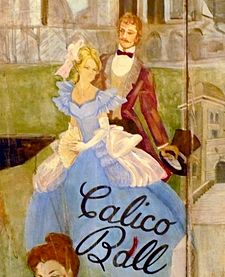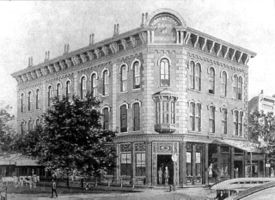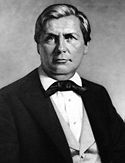Calico Ball
The Calico Ball was a landmark celebration hosted by Charles Linn at his newly-completed National Bank of Birmingham building on New Year's Eve in 1873. The gala event marked the culmination of a woeful year in Birmingham's infancy and set an optimistic tone for the coming year, during which the fortunes of the city improved greatly.
Among the calamities of 1873 were a cholera epidemic that felled or drove away most of the city's residents, and a national financial panic that disrupted industrial investment and rendered local real estate all but worthless.
Linn, one of the city's major stakeholders and business investors, was president of the National Bank of Birmingham and, despite the venture's obvious peril, pushed his three-story brick bank building to completion. The project, the tallest and grandest building yet built in the city, was labelled "Linn's Folly" by skeptics who advised him to cut his losses.
Unswayed, Linn saw the building completed in December and invited 500 guests to an opening-night celebration. As evening fell, he and his family took their places at the front door to welcome guests. At Linn's urging, and in acknowledgement of the city's financial woes, many of the ladies and gentlemen in attendance had their ball gowns and evening suits fabricated from calico. Linn modeled a brown and tan dress suit with oversize buttons. Some, such as Sallie Harrison, winner of the contest for "prettiest dress" wore "imported" finery from Montgomery.
Linn's daughter, Lizzie provided piano music on the first floor where a spread of sandwiches and coffee provided refreshment. At 9:00 PM the James T. DeJarnette band from Montgomery began playing music for reels, lancers, cotillions, rounds, and other dances in the 2nd floor ballroom. The stroke of midnight was marked by a stoppage in the music and the presentation of painted panels depicting the passing figures of 1873 and the coming glories of 1874. The dancing resumed and continued to 2:30 AM.
The Ball has lived on in the city's historical lore. Having one's family name among the roster of attendees long signaled membership among the city's oldest and most loyal families. The gala was portrayed in the "Pageant of Birmingham" during the Semicentenniel of Birmingham in 1921. The Calico Ball is also the title of a historical novel by Emma Gelders Sterne published in 1934. The novel culminates with a vivid description of the event. The Calico Ball is also depicted on Eleanor Bridges' monumental Cyclorama of Birmingham History, which was designed for the lobby of the Brown-Marx Building, built on the original site of "Linn's Folly".
Guests
- Mr & Mrs Charles Linn with their daughters, Mrs Annie Linn Matthews, Mrs Ellen Linn Watts and Miss Lizzie Linn
- Mr & Mrs J. A. Allen
- Major & Mrs D. F. Constantine
- Mr William A. Walker & Mrs Corilla Walker
- Dr Mortimer Jordan Jr & Mrs Florence Mudd Jordan
- Mr & Mrs Walter Merritt
- Mr & Mrs W. T. Parker
- Dr & Mrs James Luckie
- Dr & Mrs Pierce
- Dr & Mrs Matt Williams
- Dr & Mrs Fonville
- Mr & Mrs George Thomas
- Colonel & Mrs Hewitt
- Mr & Mrs Frank Lide
- Mr & Mrs Frank Miles
- Mr George R. Ward & Mrs Margeret Ward
- Mr William Ketchum & Mrs Jane Ketchum
- Major Willis Milner & Mrs Gustrine Milner
- Major & Mrs Jabez Curry
- Mr A. C. Oxford & Mrs Aletheia Oxford
- Mr & Mrs J. T. Nixon
- Mr & Mrs Chester Hughes
- Mr Benjamin Roden & Mrs Ella Lee Roden
- Mr & Mrs W. W. Moore
- Mr & Mrs Oliver
- Mr & Mrs W. Wood
- Mr & Mrs Eugene Gregory
- Mrs Ben Taylor
- Mr & Mrs Woodward
- Captain Tyler
- Mr & Mrs Mackay
- Mr & Mrs Gessner
- Mr & Mrs Havis
- Miss Amanda Collins
- Miss Lou Collins
- Dr Smith
- John Smith
- Joseph Riley Smith
- Mr & Mrs James Scott
- Judge & Mrs Morrow
- Mr & Mrs Gillespie
- Mr William H. Morris & Mrs Arabella Wright Morris
- Mr & Mrs Dave Bridges
- Mr & Mrs Frank O'Brien
- Mr & Mrs D. R. Dunlap
- Judge & Mrs Mitchell Porter
- Mr & Mrs J. B. Francis
- Mr & Mrs Alburto Martin
- Mr & Mrs Lykes
- Misses Lou Motes and Emma Motes
- Miss Annie Thelan
- Misses Jane Worthington and Mary Worthington
- Misses Mary Shepherd and Lula Shepherd
- MissesSallie Mudd and Mollie Mudd
- Miss Minnie Terry
- Miss Florence Perkins
- Miss Alta Deason
- Miss Sallie Porter
- Miss Dora Ward
- Miss Sallie Harrison
- Misses Rebecca Hide and Lou Lide
- Misses Mollie Fuller and Laura Fuller
- Miss Etta Hughes
- Miss Emma Iron
- Miss Jessie Crawford
- Miss Mattie Scott
- Miss Helen Robinson
- Miss Nannie Thompson
- Miss Dosia Fonville
- Miss Lucy Walker
- Miss Minnie Plosser
- Miss Nellie Tyler
- R. H. Pearson
- Henry Wilkerson and Joe Wilkerson
- J. J. Bonner
- A. O. Lane
- Henry Young
- Ossian Huggins
- William Mudd and Jim Mudd
- Will Proctor and Nelson Proctor
- Ben Williams
- Cornelius Hughes
- Major Thomas Peters
- T. C. Thompson and Asbury Thompson
- Eugene Enslen
- John Going
- T. C. McDonald
- Ira McMillan
- Green Batt
- Charles Roberts
- Dave Grace
- W. L. Scott
- John Henley
- Joseph McKee
- John Bates
- Henry Constantine
- Oscar Johnson
- Joe Worthington
- and many others
References
- Bonner, Mrs Jessie C. (n. d.) "The Calico Ball" in Early Days in Birmingham (1968) Southern University Press
- Taylor, Elberta (1940) Birmingham is My Home Birmingham: Birmingham Printing Company
- Henley, John C., Jr (1960) This is Birmingham: The Founding and Growth of an American City Birmingham: Southern University Press
- Atkins, Leah Rawls (1981) The Valley and the Hills: An Illustrated History of Birmingham and Jefferson County, Alabama. Birmingham: Birmingham-Jefferson Historical Society. ISBN 0897810317


